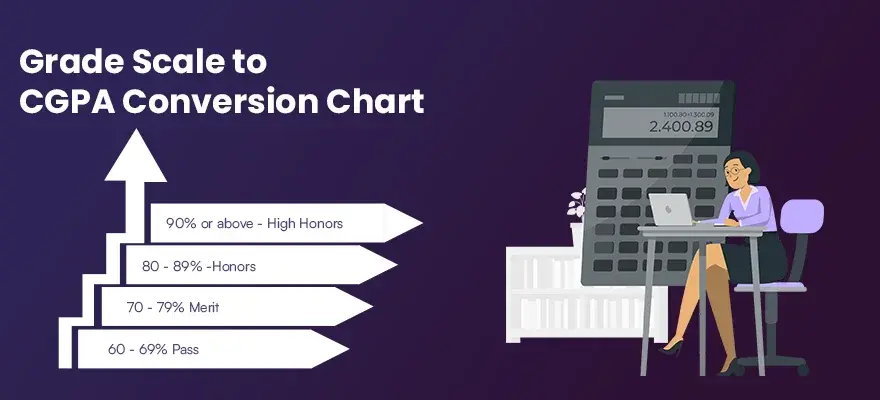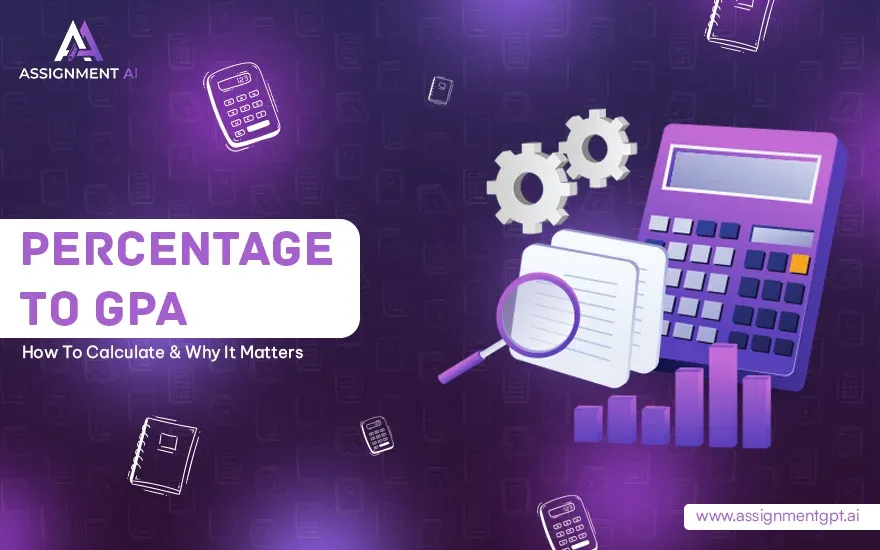AssignmentGPT Blogs
Numbers can shape the way we view our academic worth. Teachers hand out percentages, and colleges often ask for GPAs. Yet these two measures can confuse even the brightest students. Why do we talk about percentage to GPA? And what does it actually mean to switch from one system to the other? These questions keep popping up in student forums and classroom discussions. Many learners just nod and pretend they get it, all while quietly Googling “converting percentage into gpa” on their phones. This blog sets out to shed light on that puzzle in a relaxed and friendly way.
Quick Summary
You might have seen a set of digits on your report card, and then your university requests another format. It’s normal to think, “Why bother?” But shifting from percentage to GPA is a big deal, especially if you plan to study abroad or compare your academic scores across different platforms. The idea is to show how well you’ve done on a scale that many institutions trust, whether it’s a 4.0 or 10.0 system. This quick summary is your cheat sheet: it all comes down to presenting your academic record in a global format that simplifies comparisons.
Understanding Percentage and GPA
Percentages are common in many schools. You’ll see a number like 85%, which shows how much of the total marks you secured. GPA, short for Grade Point Average, is another approach, often used in universities, especially in the United States. It’s easier to read at a glance and lumps performance into a simpler scale. So if you’re converting percentage into gpa, you’re not just doing random math. You’re switching from a hundred-point system to a narrower range, which can be 4.0, 5.0, or 10.0, depending on the institution. Each method has its reasons and quirks. Some schools stick to percentages for clarity, while others believe a GPA system offers a broader view. It’s not about which is superior, though. It’s about fitting your achievements into the format that schools or employers want.
What Is A Percentage?
A percentage is a quick numerical view of your performance. If you see 80%, you know you got 80 marks out of 100. That gives an immediate sense of how well you did in a test, project, or course. Many countries rely on this method because it’s straightforward and widely recognized. You might recall teachers scolding you if you slipped a few points below that golden 90%. The advantage? Percentages leave no room for confusion, and they show small differences between students. Two people can be separated by a single point, and it’s right there on the report card.
What Is An A GPA?
A GPA is a number that scales overall performance, often on a scale from 0.0 to 4.0. In some places, it stretches up to 10.0. Rather than giving you a raw total, a GPA lumps your grades into categories. An A might hover around 4.0, a B might be 3.0, and so on. It’s like reading a scoreboard for your academic life. Instead of seeing 76%, you get something like 3.0. That might seem vague at first, but many institutions swear by it. They say it’s simpler to judge if a student’s achievements are consistent across different subjects. It’s also easier to compare GPAs between applicants during admissions.
Also read this article : Best Science Calculator for Solving Calculus problems 2024
How Is GPA Different from CGPA?
GPA and CGPA sometimes look like identical twins. In reality, CGPA is often used for a cumulative total over multiple terms, while GPA can refer to a single term or semester’s results. Think of CGPA as the entire season’s performance, whereas GPA might be one game’s score. Some colleges adopt CGPA as the grand summary of all course work across your degree. Others like to reference a semester GPA to see your short-term progress. Both revolve around the same principle: a numerical scale to represent academic performance. That said, CGPA sometimes spans a wider range, like the 10.0 system, which is popular in parts of Asia.
Calculating GPA and Understanding It
A typical 4.0 scale in the United States might look simple, but there’s always a pinch of complexity. You assign a number to each letter grade. An A is 4.0, an A– is around 3.7, and it keeps moving down as the letter changes. Weighted GPAs also pop up if courses vary in difficulty. Some advanced classes grant extra points to reward harder work. So if you’re calculating gpa from percentage, you’re basically converting a raw score into a point scale. That calculation depends on the method your school or prospective university prefers. Some use rigid tables. Others follow a formula that lumps every mark into a neat bracket.
Percentage System
A percentage system calculates the proportion of a value relative to a total, expressed as a percentage. Formula: (Part/Total) × 100. Widely used in grades, statistics, discounts, and performance metrics for clear, comparable insights.

GPA System
A GPA system calculates a student's academic performance by assigning point values (0-4.0 or similar) to grades earned in courses, then averaging them. Weighted GPAs may include course difficulty, providing a fair comparison across different curriculums.
| Letter Grade | Points | Grade Range | Percentage |
|---|---|---|---|
| A+ | 4.0 | 9.5-10.0 | 95%-100% |
| A | 3.7 | 9.0-9.4 | 90%-94% |
| B+ | 3.3 | 8.5-8.9 | 85%-89% |
| B | 3.0 | 8.0-8.4 | 80%-84% |
| C+ | 2.7 | 7.5-7.9 | 75%-79% |
| C | 2.3 | 7.0-7.4 | 70%-74% |
| D+ | 2.0 | 6.5-6.9 | 65%-69% |
| D | 1.7 | 6.0-6.4 | 60%-64% |
| F | 0.0 | 0-5.9 | 0%-59% |
Percentage to GPA Calculator 4.0 Scale
If you plan to convert gpa to 4 scale, you can rely on a formula or a handy online tool. The basic concept is that 100% gets mapped to 4.0. Divide that entire range into segments for each letter. For instance, 90–100% often translates to a 4.0. Then 80–89% corresponds to around 3.7, and so forth. You could also just pick a calculator that takes your percentage, performs the math, and spits out your approximate GPA. People sometimes fuss over decimals, but most institutions recognize that numbers can be approximate. A 3.33 vs. 3.3 difference isn’t life-altering. It’s the bigger range they care about.
Percentage to GPA Calculator 10.0 Scale
Some schools in Asia use a 10.0 scale for CGPA. It’s bigger, but the principle is the same. An 8.5 might match a 3.4 on the 4.0 scale. That’s why many global universities request clarity when they assess your transcripts. They don’t want to guess. This is where the conversion of percentage into gpa on a 10.0 scale can come in handy. If your college or scholarship program demands a 10.0 scale, you need to produce that number. The math is simple: it’s about mapping your percentage directly to a maximum of 10.0. An 80% might turn into an 8.0, while a 75% sits around 7.5. Easy enough.
What Is the Formula for Converting Percentage to GPA?
One popular approach is: (Percentage scored / 100) × 4 = GPA. So if you have 85%, you just do 85 ÷ 100, which is 0.85, then multiply by 4 to get 3.4. That’s quite straightforward, and it doesn’t demand fancy software. If you need the steps spelled out, just remember that each point on the 4.0 scale represents 25% of your raw mark. So, 1 GPA point equals 25%. This method is common and widely accepted, although some universities have unique tables that tweak those margins. Meanwhile, if you’re curious about “how to calculate gpa with percentage” in a broader sense, those unique tables matter. Still, the formula gives a ballpark figure to keep you confident during application season. As for CGPA to percentage, that’s typically CGPA × 9.5 = percentage, but that can vary across universities.
Struggling to convert your percentage to GPA? Simplify the process with the AssignmentGPT AI GPA Calculator! It’s fast, accurate, and easy to calculate your GPA from your percentage in seconds.
Can You Tell Me What a Good GPA Score Is?
A good GPA is a flexible idea. It depends on the kind of program you’re applying to, the competition you face, and the average performance in your school. Some people say anything above a 3.0 on a 4.0 scale is decent. Others demand a 3.5 or higher for top-tier admissions. In some places, a 2.5 might be acceptable for certain courses. So “good” can shift depending on your goals.
College Level
At the college level, a good GPA can unlock certain clubs or extracurricular perks. If you aim for a prized internship, they might do a quick check of your transcripts. A 3.0 or above often keeps you in the running. But if you want scholarships or a seat in high-status programs, you might need to push for something higher. Colleges vary in how they weigh this number. Some give room for improvement, trusting that first-year jitters can cause dips. Others are stricter. It’s smart to keep an eye on the minimum cutoffs, just to avoid unpleasant surprises.
High School Level
In high school, students focus on that final GPA since it’s a key factor for college admissions. High schools might define a “good GPA” in their own ways. Some will say 3.5 is the sweet spot. Others are fine with a 3.0 if you’re taking tough classes. The real point is to keep those grades consistent. Admissions boards often look for well-rounded progress. It’s not all about the final number, but a slip in your junior year can hurt. So a stable record of good marks can do wonders once you apply to your dream college.
Which Areas Where Your GPA Truly Matters
Your GPA can play a role in four main areas. First, it affects admission criteria and GPA requirements. Many schools have that magic line. Go above it, and you get a better chance. Second, there’s the scholarship angle. If you need financial help, your GPA can tip the scales in your favor. Third, job opportunities can hinge on how that number looks. Employers or internship coordinators sometimes expect a certain threshold. And fourth, clubs, societies, and on-campus leadership roles could have a minimum requirement. If you’re well above that line, you might get first pick at the more selective groups. So, yes, the number can open or close certain doors. The best approach is to aim as high as you reasonably can.
How GPA Affects College Admissions
College admissions can be a puzzle. They weigh your GPA, test scores, extracurricular activities, and personal essays. But GPA often stands out. It’s the big figure on your application. Some universities do an initial screen based on GPA. If you’re below their cutoff, they might not look further. That might seem harsh, but it helps them narrow down piles of applications. Once you clear the first hurdle, admissions teams examine how challenging your classes were. A 3.5 with a stack of honors courses can beat a 4.0 with only basic-level classes. So a strong GPA is an asset, but they still value your overall record. Don’t assume that only the final number matters.
Conclusion
So that’s the story of percentage to GPA. It looks complicated on paper, but once you see the logic, it’s pretty straightforward. The shift helps unify different scoring methods for a global audience. Whether you’re handling conversion gpa to percentage or flipping that formula, you’re just making numbers fit into a preferred scale. If you’re looking for a tool that makes this easy, AssignmentGPT AI GPA Calculator can give quick results on both 4.0 and 10.0 scales. It’s a solid way to confirm you’re on the right track.
FAQs
1. How do I begin converting percentage into gpa for my applications?
2. Why is percentage to gpa so popular for study abroad?
3. Can I convert gpa to 4 scale from any percentage figure?
4. Does the conversion of percentage into gpa work the same on a 10.0 scale?
5. Does conversion gpa to percentage hurt my final score?
Content writer at @AssignmentGPT
Kandarp’s world is powered by conversations, content, and creativity. With experience across branding, literature, publishing, and strategy, he has helped shape identities and stories for businesses across industries. At AssignmentGPT AI, he leads a team that blends sharp content, strong design, and local insight to turn businesses into brands that connect with people.
Master AI with
AssignmentGPT!
Get exclusive access to insider AI stories, tips and tricks. Sign up to the newsletter and be in the know!

Transform Your Studies with the Power of AssignmentGPT
Empower your academic pursuits with tools to enhance your learning speed and optimize your productivity, enabling you to excel in your studies with greater ease.
Start Your Free Trial ➤Start your success story with Assignment GPT! 🌟 Let's soar! 🚀
Step into the future of writing with our AI-powered platform. Start your free trial today and revolutionize your productivity, saving over 20 hours weekly.
Try For FREE ➤








